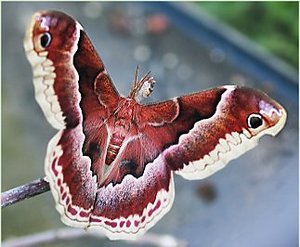This must be my Saturniidae summer. After experiencing the quiet wonder of the emergence of two Polyphemus and lamenting that I rarely see wild silkmoths anymore, I spotted my first Cecropia in over 20 years, and now I’ve encountered my first Promethea moth, Callosamia promethea.
Last week I found two cocoons on a sumac, one of which was empty. I recognized them as silkmoth cocoons, but recalled no species with larvae that fed on sumac. The cocoons matched those of the Promethea, which feeds primarily on sassafras, spicebush, and cherries, although I didn’t notice seeing these in the immediate area of the cocoons. I brought the cocoon home, wondering if it was alive, and if so, what would emerge.
 When we returned from our long weekend, I looked in the aquarium and there was a gorgeous Promethea. Like all silkmoths, this one was breathtaking, richly patterned in shades of cinnabar, rust, and cream, with a sprinkling of lavender. This coloring indicated the moth was a female, as Prometheas are highly dimorphic; the males are the color of dark chocolate. But there was another giveaway to its gender. The sex of silkworm moths can be determined by the shape of their antennae.
When we returned from our long weekend, I looked in the aquarium and there was a gorgeous Promethea. Like all silkmoths, this one was breathtaking, richly patterned in shades of cinnabar, rust, and cream, with a sprinkling of lavender. This coloring indicated the moth was a female, as Prometheas are highly dimorphic; the males are the color of dark chocolate. But there was another giveaway to its gender. The sex of silkworm moths can be determined by the shape of their antennae.
 Moth antennae come in various shapes. Some are filiform (threadlike) and simple (no lateral projections). Most do have projections, which are described by their structure; for example, ciliate (hair-like), setose (bristle-like), dentate (tooth-like), or pectinate (comb-like, singly or in pairs). Excessive pectination, resembling a feather, is called plumose. Recall my Polyphemus moths, which were male (top right). Now there are some plumose antennae! The antennae on the female Promethea, as you can see, are much more modest (below right).
Moth antennae come in various shapes. Some are filiform (threadlike) and simple (no lateral projections). Most do have projections, which are described by their structure; for example, ciliate (hair-like), setose (bristle-like), dentate (tooth-like), or pectinate (comb-like, singly or in pairs). Excessive pectination, resembling a feather, is called plumose. Recall my Polyphemus moths, which were male (top right). Now there are some plumose antennae! The antennae on the female Promethea, as you can see, are much more modest (below right).
Adult silkmoths live for just a fortnight and do not eat or drink. Their goal is to reproduce. Most females don’t even fly until they have mated. They just sit near their old cocoons, release pheromones, and await a male. Here, then, is the reason for the male’s extravagant antennae: they are used to sweep the air for the scent of a female. Equipped with exquisitely sensitive chemoreceptors, they are able to detect a female two to five miles away, sometimes much farther.
Females of different species release their pheromones at different times of the night. Polyphemus females “call” before midnight, Luna moths begin around the witching hour, and Cecropias begin at 2 or 3 AM. Prometheas are one of the few diurnal silkmoths, and call in late afternoon.
When this Promethea did not attract a male in two afternoons, I returned her to the area where I found her, releasing her to fulfill her purpose. Somewhere, I hoped, the elaborate feathery antennae of a male will detect a few molecules of her scent, and he will go to her, following her invisible, silent, siren song.

Comments on this entry are closed.
As someone who is fascinated with all things lep, thank you for this most informative article. I am presently rearing 36 promethea larvae, found 6 giant swallowtail larvae this evening, and two spicebush eggs. Much fun.
Oh, boy. I'm jealous!
a week or so ago, we had a LUNA moth flying around outside our window in Ann Arbor! That's the first time I have seen one on our property.
I enjoyed your note. You might enjoy my similar remembrance in "MothCatcher", 2007, Univ. of Nevada Press; and further stories on studying evolution in moths.
Best regards – MMC
i found a little yellow cocoon the other day and we thionk its a moth how do we know what it will be? can some one help?